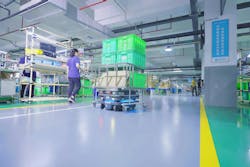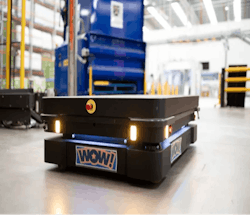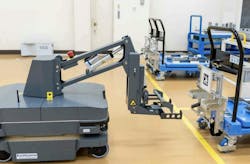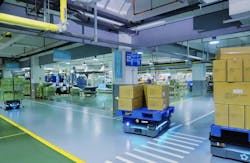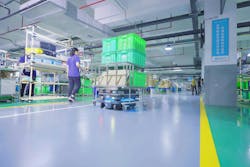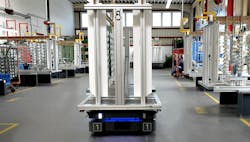Assessing the Technical Feasibility of Implementing an AMR System
Integrating autonomous mobile robot (AMR) systems into a facility presents the opportunity to streamline industrial operations. The successful implementation of such advanced technology, however, hinges on a complete assessment of technical considerations to ensure a seamless deployment.
Drawing insights from our education series with interviews conducted with Rishabh Aurora, team lead for application engineering, and Tim Ideker, applications engineer, both at Mobile Industrial Robots (MiR), Machine Design was able to uncover considerations and strategies essential for the integration and scalable deployment of AMRs in modern workplaces.
By tapping into their expertise, we gain perspective on the nuances of AMR technology adoption from selecting the right robots and optimizing plant layouts to addressing challenges that help ensure safety compliance and maximizing return on investment. Aurora’s and Ideker’s input shed light on the dynamics of incorporating automation into operational workflows and providing a comprehensive guide to leveraging the potential of AMRs in facilities.
Know Payload Requirements, Plant Routes
The foundation of a successful AMR system lies in the selection of the right robot tailored to specific payload requirements as well as plant layout for route planning.
Factors such as payload size, weight capacity and the need for specialized modules like pallet lifts or cart manipulators must be fully evaluated to optimize operational efficiency. To maximize productivity, it’s important to choose the appropriate robot that can handle the designated tasks.
Effective plant layout design and route planning help ensure smooth navigation for AMRs within a facility. Assessing the availability of space, identifying obstacle-free pathways and establishing optimal travel routes can help with overall operational agility.
By selecting the right robot and strategically designing the layout and routes, businesses can optimize efficiency, minimize downtime and maximize the productivity of their AMR fleet.
Integration with Existing Systems, Employees
Integrating AMRs with pre-existing warehouse management or enterprise resource planning (ERP) systems is important for the cohesive functioning of the operational ecosystem. Conducting compatibility tests, establishing systematic integration protocols and ensuring data synchronization between different systems are aspects to consider during the implementation process. A well-integrated system enables real-time data exchange, as well.
The interaction between operators and AMRs also plays a role in the smooth operation of the automated system. Implementing user-friendly interfaces, intuitive control panels and clear communication channels facilitate effective coordination between human workers and autonomous robots. Providing training on how to interact with AMRs and addressing any communication challenges can optimize workflow efficiency and ensure collaboration.
Clearly defining the roles and responsibilities of personnel involved in the implementation process is necessary to establish accountability and promote efficient operations. From operators responsible for overseeing daily tasks to maintenance staff tasked with system upkeep, assigning clear roles ensures smooth coordination and effective task allocation.
Connectivity, Environmental and Software Considerations
Reliable connectivity is a requirement for maintaining uninterrupted communication between AMRs and the central fleet management system. By ensuring a stable communication network and creating a conducive environment for AMR operations, businesses can enhance the reliability and performance of their automated systems.
Assessing environmental factors such as floor conditions, localization objects and temperature control also must be considered for sustaining operational efficiency and minimizing potential disruptions.
The selection of sensors, both onboard and external, coupled with software integration, can aid in the functionality and adaptability of AMR systems. Advanced sensors enable precise navigation, object detection and obstacle avoidance, while integrated software solutions provide real-time data analytics and decision-making support.
PoC Testing, Risk Assessment, Safety Compliance
Evaluating the integration of AMRs with existing infrastructures and workflows is necessary to transition to an automated operational model. Conducting compatibility checks, addressing navigation challenges and performing proof of concept (PoC) tests ensure that the AMR system integrates with the existing environment. This can help minimize potential disruptions and optimize performance.
Risk assessment and safety compliance adhering to established safety standards, conducting comprehensive risk assessments and implementing systematic safety protocols are imperative to ensure a secure operational environment for AMRs.
Prioritizing safety measures such as emergency staff mechanisms, sensor-based collision avoidance systems and regular maintenance checks minimizes the risk of accidents and enhances overall safety of AMR deployment. By emphasizing safety compliance and risk management practices, organizations can create a secure working environment and boost employee confidence working alongside autonomous robots.
Return on Investment Analysis
Determining the return on investment (ROI) for an AMR implementation involves evaluating a range of factors, including labor redeployment efficiency, operational cost savings and safety benefits. Calculating the tangible and intangible benefits of deploying AMRs such as increased productivity, reduced cycle times and enhanced workplace safety enables businesses to assess the long-term value proposition of automation. By quantifying the impact of AMRs on key performance indicators and financial metrics, organizations can make informed decisions regarding investment in autonomous technologies and measure the effectiveness of their implementation strategy.
For more AMR insights from MiR, be sure to check out our three-part video series:
About the Author
Sharon Spielman
Technical Editor, Machine Design
As Machine Design’s technical editor, Sharon Spielman produces content for the brand’s focus audience—design and multidisciplinary engineers. Her beat includes 3D printing/CAD; mechanical and motion systems, with an emphasis on pneumatics and linear motion; automation; robotics; and CNC machining.
Spielman has more than three decades of experience as a writer and editor for a range of B2B brands, including those that cover machine design; electrical design and manufacturing; interconnection technology; food and beverage manufacturing; process heating and cooling; finishing; and package converting.
Email: [email protected]
LinkedIn: @sharonspielman
Facebook: Machine Design
YouTube: @MachineDesign-EBM
